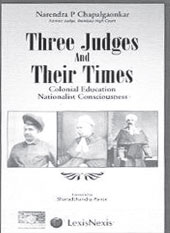Authors : Justice Narendra Chapalgaonkar
Translation : Sharadchandra Pendse
Publisher : LexisNexis
Year of Translation Publication: 2013
Price : Rs. 295
This book portrays a vivid picture of the foundational years of India’s legal entities as they evolved through the study of the lives of the three iconic figures of Indian Judiciary, namely, Justice Kashinath Trimbak Telang, Justice Mahadev Govind Ranade and Justice Narayan Ganesh Chandavarkar. All of them, outstanding judges of the Bombay High Court in the late 19th century and the early 20th century, they were part of the processes that shaped the ground for the judiciary and legislation to evolve under an empire that was at its zenith.
As the author, himself an outstanding judge of the Aurangabad Bench of the Bombay High Court states, this is not a biography of the three judges nor is it an account of history. It is rather written as fond remembrance and as a tribute to the memory of the contributions of the three judges made to their times, on and off the bench. The genesis of the idea of a book, as the author states, rose in the hallowed environs of the Bombay High Court itself and took shape in a form of three lectures that were delivered at the ILS Law School, Pune in the year 2006 by the author. Later in a more structured manner the book was first conceptualised and written in Marathi in the year 2010. Now in the translated form this body of work is being made available for the non-Marathi speaking readership and audience.
The work has been brought out in nine neatly laid out chapters. Chapters one and two lay down the general context of the times in terms of the historical backdrop and the measures initiated by the British. The third chapter delineates biographical sketches of the three judges. Chapters four to eight delve into the contributions made by the three judges in diverse fields such as religion, economics, politics, and judicial and social reforms. The last chapter brings together the discourse in the context of the present and discusses the relevance of the three judges in the context of the day.
The work cogently brings out the liberal outlook of the three judges even in the overall colonial rule of the day and the fearless attitude of the judges as they actively participated and helped shaped the contours of the Bombay High Court and the legal jurisprudence. The book also notes some startling coincidences, one of them being that all the three were educated at the Elphinstone College and were part of the Council of Governor of Bombay at one point or the other. The three were also remarkably active in the political arena and were present and associated with the process of founding of the Indian National Congress in the year 1885 and were physically present in the first session of the Congress in Mumbai.
Of the three, of course Justice Ranade undoubtedly stands out for his remarkable range of interests and scholarship, as well as, his seminal contribution to the Prarthana Samaj and many other institutions he supported. He provided the framework for an informed discussion on the political economy and general economic issues of those times. Along with him, the contributions and the range of interests displayed by Justice Telang and Justice Chadavarkar were of considerable importance as they provided the strength to the liberal ethos. They individually and collectively helped
shape the liberal ethos of the judiciary of the day and were not hesitant to take up issues of society and politics that were germane to their hearts.
The author, due to the legal background he comes from has brought in those insights into the text rather well. The book ably translated holds the attention of the reader till the end and is an important contribution to the issues that were germane to the late 19th and early 20th century. This book would be of particular interest to the students of history, political science, law and sociology as it attempts to sketch the legal framework of that era.

